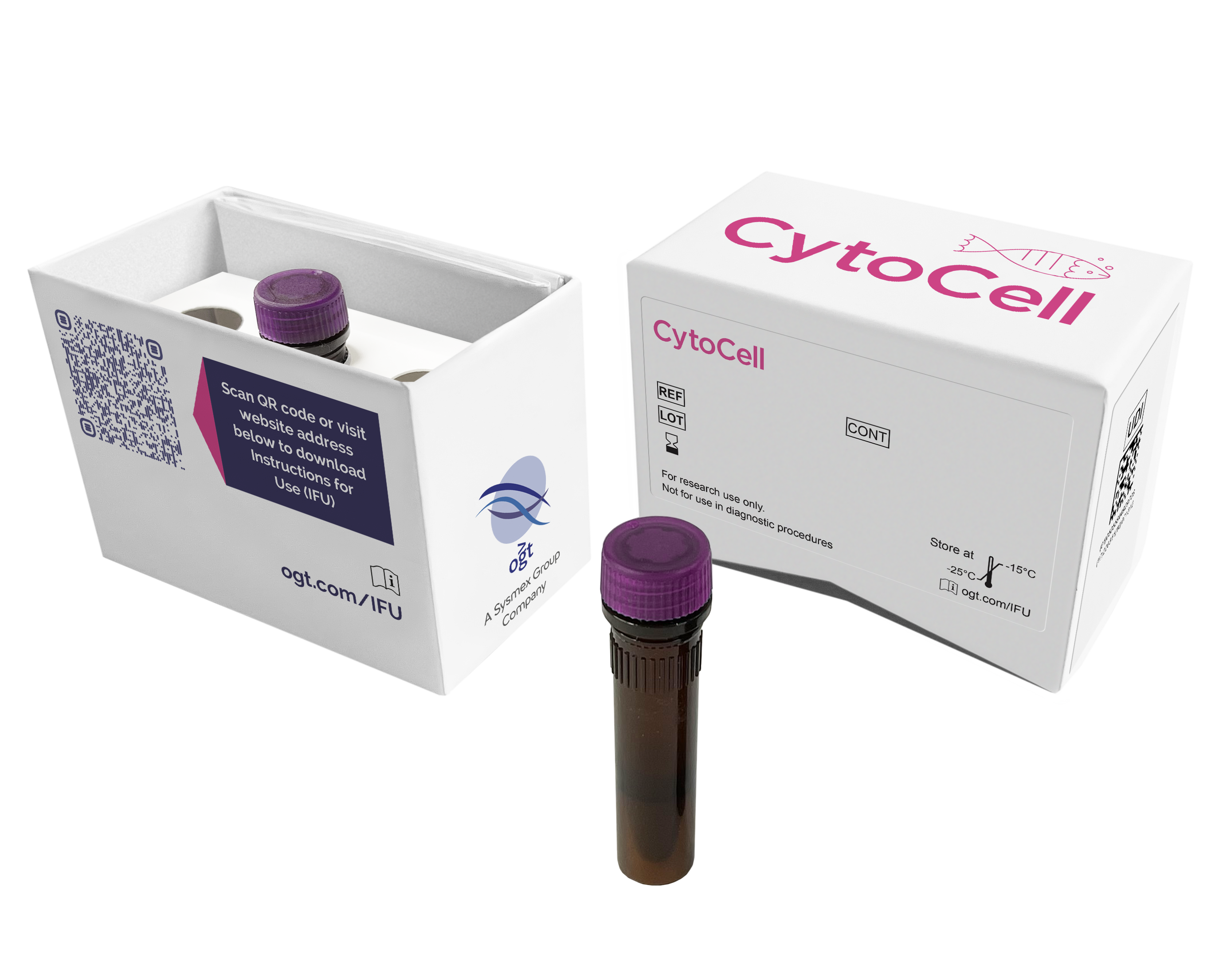
The TCRAD product consists of a 225kb probe, labelled in red, located at the centromeric end of the Variable Region of the immunoglobulin gene cluster, including the G36107 marker and a green probe covering a 143kb region located telomeric to the TRAC gene, including the entire OXA1L gene and the G35927 marker.
Chromosomal translocations with breakpoints in alpha and delta T-cell receptor (TCR) gene loci at 14q11.2 are recurrent in several T-cell malignancies including T-cell acute lymphoblastic leukaemia (T-ALL)1.
T-cell acute lymphoblastic leukaemia (T-ALL) is an aggressive malignancy of the lymphoblasts committed to the T-cell lineage and represents 15% of childhood and 25% of adult ALL2,3. Karyotyping reveals recurrent translocations that activate a small number of oncogenes in 25-50% of T-ALLs but, with FISH, further cryptic abnormalities can be revealed2.
The most common chromosomal rearrangements, found in about 35%2 of T-ALLs, involve the alpha and delta T-cell receptor loci (TRA and TRD) at 14q11.2, the beta TCR locus (TRB) at 7q34 and the gamma TCR (TRG) at 7p14. In most cases the juxtaposition of oncogenes next to the TCR regulatory sequences leads to the deregulated expression of these genes2,4,5.
The TRA/D complex at 14q11.2 has been shown to be involved in a number of different translocations in T-ALL. These include the t(10;14)(q24;q11) involving TLX1; the t(1;14)(p32;q11) involving TAL1; the t(14;21)(q11;q22) involving the OLIG2; the t(11;14)(p15;q11) involving LMO1 and the t(11;14)(p13;q11) involving LMO22.
In addition to T-ALL, TRA/D translocations are recurrent in T-non- Hodgkin’s lymphoma and T-prolymphocytic leukaemia. They have also been reported in cases of ataxia telangiectasia (AT)1.
Find certificate of analysis documentation for our CytoCell FISH probes

Our lab has been using a wide range of CytoCell FISH probes for a number of years, and have been increasing this range all the time. The probes have clear bright signals and show good reproducibility. CytoCell provides fast delivery of catalogue probes, and are very responsive when we have any queries or problems with their products.

Bridget Manasse
Addenbrookes Hospital, Cambridge University Hosiptals NHS Foundation Trust, UK
In our hands, CytoCell FISH probes have proven to be of the highest quality with bright, easy to interpret signals, thus providing confidence in our results. OGT's customer support is outstanding, as their staff are extremely knowledgeable and truly care about their customers and their customers’ needs.

Jennie Thurston
Director of Cytogenetics, Carolinas Pathology Group, USA
I first came across CytoCell FISH probes in a previous lab I worked in and I was struck by the quality of the products. Since this time, I have been recommending and introducing CytoCell probes across all application areas — now they are the primary FISH probes used in our lab. They have an excellent range of products and their ready-to-use reagent format saves considerable time.

Elizabeth Benner
Medical Technologist, University of Arizona Health Network, USA
We have been working with CytoCell fish probes for two decades because of their excellent clarity and intensity regardless of the size of the probe. It is so clear and simple to detect.
Dr. Marina Djurisic
Head of Laboratory of Medical Genetics, Mother and Child Health Care Institute of Serbia “Dr Vukan Cupic”, Serbia
The quality and consistency of CytoCell’s probes means I can trust the results, and my clients get their results in a timely manner.

Dr. Theresa C. Brown
Director, Cytogenetics Laboratory, Hayward Genetics Center, Tulane University School of Medicine, USA
It was very important for us to have more consistent results with our probes — easy-to-read bright signals and a range of vial sizes, which is much more cost-effective.

Janet Cowan, PhD
Director of the Cytogenetics Laboratory, Tufts Medical Center, USA
Not only do CytoCell offer an extensive range of high-quality FISH probes, the customer support is also excellent — providing fast access to all the probes I need. The probes are highly consistent with bright signals allowing easy scoring of results.
Dr. Eric Crawford
Senior Director, Genetics Associates Inc., USA
The quality and reproducibility of results using the CytoCell kit has been vital in accurately detecting co-deletions in our glioma investigations. We now have a cost-effective test that we can rely on that is also easy to use and interpret. We've been consistently impressed with this kit - not to mention the support offered by OGT's customer service, and have completely transitioned over to CytoCell probes.
Gavin Cuthbert, FRCPath
Head of Cancer Cytogenetics, Northern Genetics Servce, Newcastle, UK